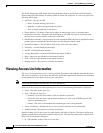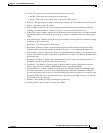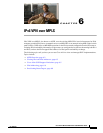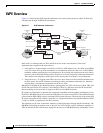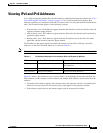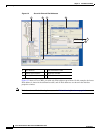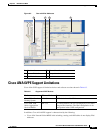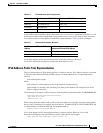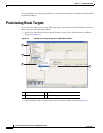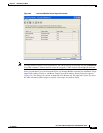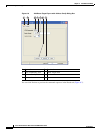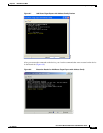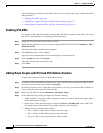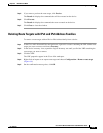
6-6
Cisco Active Network Abstraction 3.6.6 MPLS User Guide
OL-19192-01
Chapter 6 IPv6 VPN over MPLS
IPv6 Addressing
• The Cisco ANA NetworkVision VRF table does not display IPv6 VRF routing information.
• If an interface or subinterface does not have an IPv4 or IPv6 IP address, the interface is not
discovered and not shown in Cisco ANA NetworkVision.
• The Layer 1 topology between 6VPE and an IPv6 CE is discovered only when CDP is enabled.
• BGP neighbor discovery does not occur between PE and CE interfaces configured with IPv6
addresses only.
• Correlation flows between IPv6-only interfaces is not supported.
IPv6 Addressing
IPv6 addresses are 128-bit identifiers for interfaces and sets of interfaces. Cisco ANA supports the
following IPv6 address types:
• Unicast—Identifier for a single interface. A packet sent to a unicast address is delivered to the
interface identified by that address.
• Anycast—Identifier for a set of interfaces (typically belonging to different nodes). A packet sent to
an anycast address is delivered to one of the interfaces identified by that address (the “nearest” one,
according to how the routing protocol measures distance.
• Multicast—Identifier for a set of interfaces (typically belonging to different nodes). A packet sent
to a multicast address is delivered to all interfaces identified by that address.
Cisco ANA supports interfaces with multiple IPv6 addresses. The lowest IPv6 address is presented in
the Cisco ANA tables; all addresses are shown in the detailed interface properties view. Cisco ANA does
not model link-local unicast addresses because they are not used in the routing and forwarding tables.
The following sections provide additional IPv6 address format information:
• IPv6 Address Representation, page 6-6
• IPv6 Address Prefix Text Representation, page 6-7
Note For more IPv6 addressing information, see “RFC2460 - Internet Protocol, Version 6 (IPv6
Specification.”
IPv6 Address Representation
IPv6 has three conventional text string representation forms. The preferred form is x:x:x:x:x:x:x:x,
where x is the hexadecimal value of the eight 16-bit address pieces, for example:
FEDC:BA98:7654:3210:FEDC:BA98:7654:3210
1080:0:0:0:8:800:200C:417A
Because IPv6 addresses frequently contain long strings of zero bits, two colons (::) can be used to
indicate multiple 16-bit groups of zeros. Table 6-3 shows examples.



